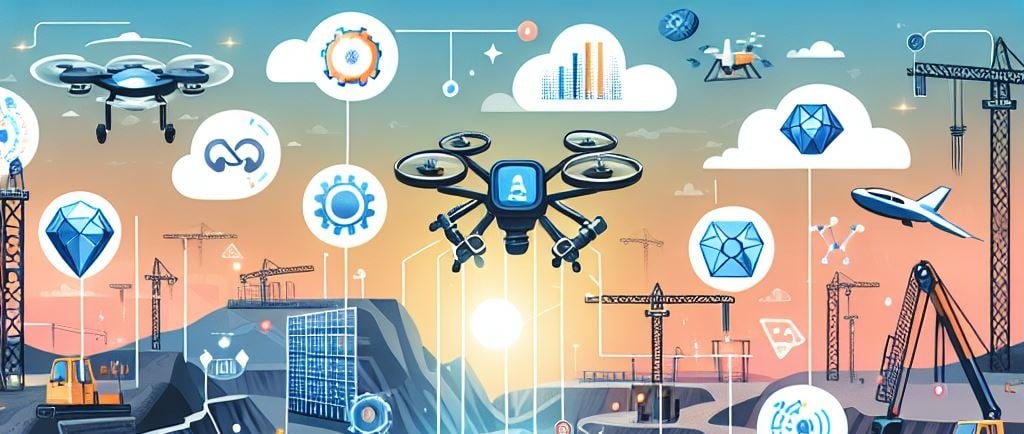Revolutionizing Mining Exploration: Unleashing the Power of Large Generative AI Models
Xuan-Ce Wang
11/27/20248 min read


Abstract:
Embark on a journey through the transformative impact of large generative AI models on traditional mining exploration. In this report, we delve into the opportunities and challenges posed by the rapid development of generative AI models in deep learning. Our focus lies on how these models enhance mineral exploration, elevate industry standards, and confront risks. Through a comprehensive analysis, we unveil the exciting prospects brought by large generative AI models to the mining sector and advocate for prudent risk management and ethical standards to ensure their responsible and sustainable application.
Key Points:
Efficiency Unleashed: Improving Mineral Exploration Accuracy
The exploratory design capabilities of generative AI models synthesize data for research and analysis, offering efficient and accurate predictions for mineral resource distribution, characteristics, and grades.
Multi-source, multi-scale, and multi-modal geological data, coupled with machine learning and pattern recognition, empower generative AI models to extract latent variables, reducing human errors and enhancing exploration precision.
Mining 2.0: Intelligent Transformation and Upgrade
Generative AI models, in synergy with the Internet of Things, big data, and cloud computing, forge an intelligent architecture for the industrial Internet, providing mining with efficient, safer, and environmentally friendly technological solutions.
From intelligent sensing and control of mining equipment through IoT to cloud-based applications, these models optimize operations, predict faults, and enable remote operations, catapulting the industry into a new era of productivity and sustainability.
Educational Renaissance: Enriching Training and Promotional Materials
Videos, narratives, and training data generated by AI models revolutionize educational training and promotional materials in the mining industry.
Tailored content enhances the effectiveness and efficiency of education and training, while innovative promotional materials showcase industry achievements, fostering a deeper understanding among practitioners and the general public.
Navigating Risks: Addressing Challenges of Generative AI
Deepfakes, copyright issues, and malicious attacks pose challenges that demand robust security and risk management for generative AI in mining.
Strengthening legal regulations and ethical standards is imperative to ensure the responsible and sustainable use of generative AI, safeguarding national security, public interests, and individual rights.
In-depth Exploration:
1. Efficiency Unleashed: Improving Mineral Exploration Accuracy
Generative AI models, harnessing the power of deep learning, automatically generate text, images, audio, and video, revolutionizing various industries. In mineral exploration, these models offer a paradigm shift by utilizing synthesized data for research and analysis. This results in efficient and accurate predictions for the distribution, characteristics, and grade of mineral resources, leading to significant time and cost savings.
Specifically, generative AI models leverage multi-source, multi-scale, and multi-modal geological data. Employing techniques such as machine learning, pattern recognition, and inductive reasoning, these models automatically or semi-automatically extract latent variables from the data. This process aids in building models to predict and evaluate mineral resource distribution and potential, reducing human interference and errors. For example, the Institute of Geology and Geophysics, Chinese Academy of Sciences, employed generative AI models to assess lithium resources on the Tibetan Plateau, uncovering new lithium mining areas crucial for China's new energy industry.
Furthermore, generative AI models utilize big data and artificial intelligence technologies to model and analyze complex geological systems. This approach reveals intrinsic mechanisms and patterns, expanding the scope and perspective of exploration. Peking University's research team, for instance, applied generative AI models to conduct in-depth research on global geological data, uncovering new phenomena and Earth processes. This innovative approach provides a fresh perspective for the development of Earth science.
The integration of generative AI models with open platforms and data-sharing mechanisms promotes cross-disciplinary integration, fostering innovation and transformation in exploration. The research team at Tsinghua University utilized generative AI models to establish an open materials information platform, supporting the research and application of materials science and engineering.
In summary, the application of generative AI models in mineral exploration enhances efficiency and accuracy, broadening the field and perspective of exploration, and promoting innovation. These applications contribute not only to enhancing China's mineral resource security but also to supporting green development and technological innovation.
2. Mining 2.0: Intelligent Transformation and Upgrade
The marriage of generative AI models with technologies like the Internet of Things (IoT), big data, and cloud computing ushers in an era of intelligent transformation for the mining industry. This amalgamation achieves an intelligent architecture for the industrial Internet, providing mining with more efficient, safer, and environmentally friendly technological solutions.
1) Achieving intelligent sensing and control of mining equipment:
Through IoT technology, various devices, sensors, cameras, and other equipment in mines form an intelligent network. Real-time collection and transmission of data, such as temperature, pressure, humidity, gas levels, geology, and equipment status, are accomplished. Generative AI models analyze and process this data, extracting useful information to generate visual reports. This provides support for mine management and decision-making.
Moreover, generative AI models can intelligently control mining equipment, adjusting parameters, optimizing operations, predicting faults, and enabling remote operations. This not only improves mining efficiency but also enhances safety.
2) Achieving intelligent design and optimization of mines:
Big data technology plays a pivotal role in achieving intelligent design and optimization. Historical data, on-site data, external data, and more are integrated and stored, forming a massive data resource. Generative AI models conduct in-depth mining and analysis, revealing the inherent laws and mechanisms of mines.
Generative AI models create synthetic geological data for the study and analysis of the distribution, characteristics, and grade of mineral resources. This is achieved without the need for extensive field sampling and testing, saving time and costs and improving exploration efficiency and accuracy. Additionally, these models optimize mine development plans, ore processing processes, energy conservation, and emission reduction, enhancing economic and environmental benefits.
3) Achieving intelligent services and innovation in mining:
Cloud computing technology facilitates the deployment of mining data and applications in the cloud. This realization enables data sharing and collaborative applications for mines. Generative AI models enhance and extend mining data and applications intelligently, providing the industry with flexible services and an innovative platform.
For example, generative AI models generate videos, narratives, training data, and other content, offering richer, more vivid, and easily understandable educational training and promotional materials. They also contribute to the creation of new mining products, services, and models, providing innovative opportunities and competitive advantages.
In conclusion, the combination of generative AI models with IoT, big data, and cloud computing achieves an intelligent architecture for the industrial Internet. This not only enhances productivity and competitiveness but also supports the green development and technological innovation of the mining industry.
3. Educational Renaissance: Enriching Training and Promotional Materials
Generative artificial intelligence models, with their significant progress in recent years, offer a wealth of opportunities for educational training and promotional activities in the mining industry. Content generated by these models, including videos, narratives, and training data, provides richer, more vivid, and easily understandable materials, thereby revolutionizing industry promotion and development.
1) Improving the effectiveness and efficiency of education and training:
Generative AI models tailor content such as videos, narratives, and training data to different levels, needs, and styles of education and training in the mining industry. This diversity enables personalized and intelligent teaching resources. Practitioners and managers can improve their understanding and mastery of knowledge, skills, standards, and innovation.
For example, NetDragon Websoft Holdings Limited utilizes generative AI models to provide intelligent education solutions for the mining industry. This includes generating complete post-class review content through classroom recordings, covering explanations of each knowledge point, extending to videos, exercises, and teacher Q&A resources, all presented in a structured manner.
2) Enhancing the impact and appeal of promotional activities:
Generative AI models generate content suitable for different occasions, media, and formats, providing rich, vivid, and interesting promotional materials for the mining industry. These materials showcase industry achievements, innovative outcomes, and social value, enhancing the impact and appeal of promotional activities.
Tencent, for instance, employs generative AI models to provide intelligent promotional solutions for the mining industry, including videos, narratives, and training data. This content aims to provide the mining industry with richer, more vivid, and easily understandable educational training and promotional materials, supporting industry promotion and development.
3) Promoting innovation and collaboration in education and training and promotional activities:
Generative AI models continuously optimize and update generated content based on the needs and feedback of education and training and promotional activities. This ongoing innovation promotes cross-disciplinary integration through open platforms and data-sharing mechanisms, forming new paradigms and models for education, training, and promotion.
Baidu provides intelligent education and promotional solutions for the mining industry using generative AI models. This includes generating videos, narratives, training data, and other content to provide richer, more vivid, and easily understandable educational training and promotional materials, supporting industry promotion and development.
In summary, generative AI models contribute significantly to education and training, as well as promotional activities in the mining industry. Their ability to generate diverse and personalized content revolutionizes the learning experience and enhances the industry's promotional efforts.
4. Navigating Risks: Addressing Challenges of Generative AI
Generative AI has ushered in new opportunities and challenges across various industries. However, it comes with inherent risks such as deepfakes, copyright issues, and malicious attacks that could jeopardize national security, public interests, and the rights of individuals and organizations. To effectively address these challenges, a series of comprehensive measures must be implemented.
1) Strengthening laws, regulations, and ethical standards:
The foundation and guarantee for regulating the development and application of generative AI lie in laws, regulations, and ethical standards. It is crucial to stay abreast of technological advancements and social impacts, clearly defining the scope, responsibilities, rights, and obligations surrounding generative AI. Corresponding regulatory measures and punishment mechanisms should be formulated to prevent misuse and abuse, protecting legal interests and social values.
China has taken strides in this direction by issuing interim measures for the management of generative AI services and proposing safety basic requirements for generative AI services. These efforts regulate and guide various aspects of generative AI's technological development, service provision, content generation, and safety assessment.
2) Building technological innovation and security prevention capacity:
Technological innovation and security prevention are pivotal for improving the quality and reliability of generative AI. Increased investment in research and development, along with talent training, is necessary to promote independent innovation in the basic technology of generative AI, including algorithms, frameworks, chips, and platforms.
Furthermore, transparency, interpretability, and controllability of generative AI should be enhanced. Strengthening the security assessment and monitoring of generative AI is vital, utilizing technical measures such as digital watermarking, blockchain, anti-counterfeiting algorithms, and more to prevent tampering, forgery, and leakage. Tencent, for example, employs generative AI technology alongside various technical means, such as manual review, content identification, and user feedback, to ensure the authenticity and legality of generated content.
3) Guiding social education and fostering public participation:
Social education and public participation are integral to increasing social awareness and reaping social benefits from generative AI. A concerted effort should be made to strengthen popular science propaganda and widespread education about generative AI. This involves improving public understanding of various aspects of generative AI and guiding ethical considerations.
Additionally, mechanisms for public complaints, reports, supervision, and public participation should be established and refined. This encourages active involvement of the public in the governance and supervision of generative AI, safeguarding their legitimate rights and interests. For instance, the Institute of Geology and Geophysics, Chinese Academy of Sciences, uses generative AI technology to assess lithium resources on the Tibetan Plateau. Simultaneously, they engage in public education through online platforms and media channels, improving awareness and trust in generative AI.
5. Conclusion
While generative AI models hold immense potential for traditional mining exploration, it is imperative for the industry to address potential risks and challenges. Establishing a scientific management system and ethical standards is vital to ensure the safe, responsible, and sustainable application of generative AI. Our collective exploration of the future path of generative AI models in mining is a testament to the collaborative efforts and dedication of our team members, to whom we extend our heartfelt gratitude. Together, we pave the way for a new era in mining exploration.








